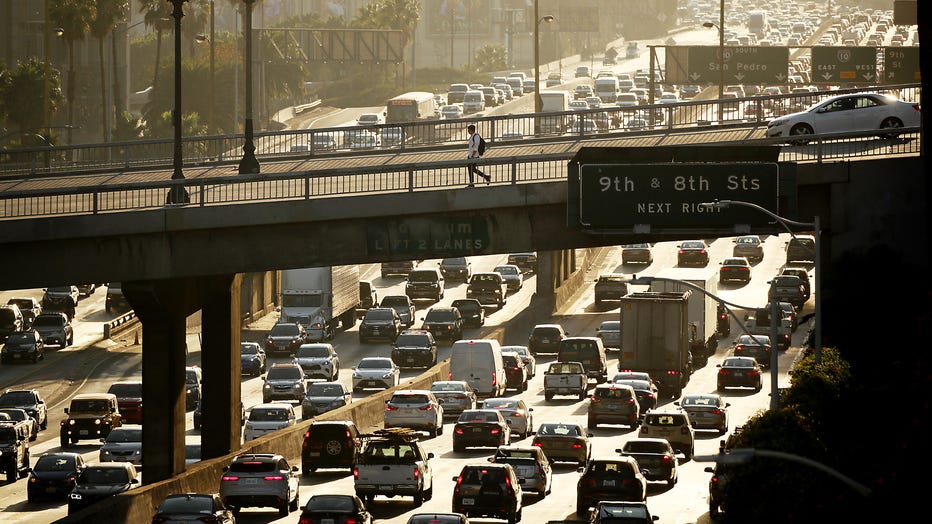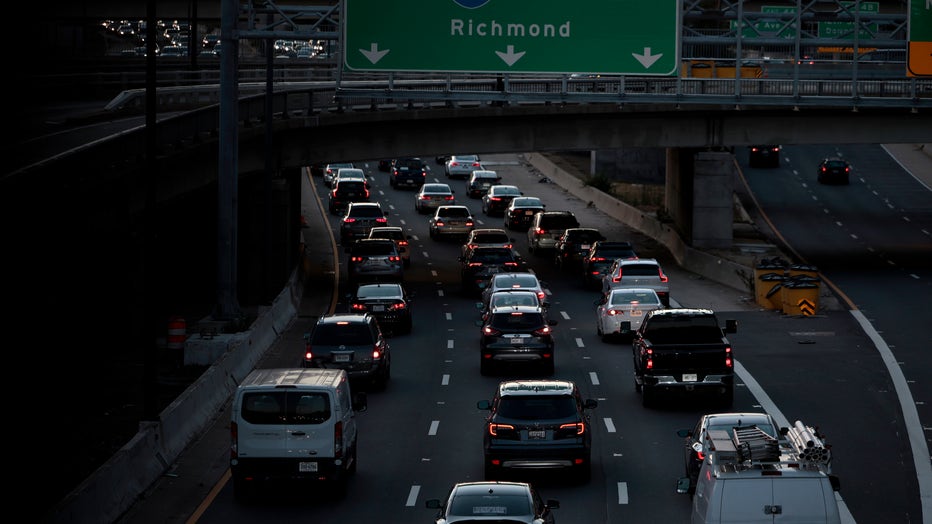Thanksgiving travel forecast: Roads, runways will be jammed, experts say
Higher gas prices and more expensive plane tickets don’t appear to be keeping people home for the holidays: Thanksgiving travel is expected to be among the busiest we’ve seen in decades.
Auto club AAA estimates that 54.6 million people will travel 50 miles or more from home this Thanksgiving — a 1.5% increase over 2021 and 98% of pre-pandemic volumes. This year is expected to be the third-busiest for holiday travel since AAA started tracking the numbers in 2000.
Here’s what you can expect on highways and at airports for Thanksgiving this year.
Cities with the worst Thanksgiving holiday traffic
Thanksgiving is one of the busiest holidays for driving, and this year will be no different. According to data compiled by INRIX, severe congestion is expected in several U.S. metro areas, with some drivers experiencing more than double the normal delays. The busiest highways will be in Atlanta, Chicago, New York City and Los Angeles.

Traffic slows on the Harbor Freeway in downtown Los Angeles on Thanksgiving getaway day on Wednesday, Nov. 24, 2021. (Luis Sinco / Los Angeles Times via Getty Images)
Here are the cities with the worst Thanksgiving traffic:
Atlanta peak traffic time: 1:30 p.m. - 3:30 p.m. on Wednesday, Nov. 23
Boston peak traffic time: 2:15 p.m. - 4:15 p.m. on Wednesday, Nov. 23
Chicago peak traffic time: 3 p.m. -5 p.m. on Wednesday, Nov. 23
Detroit peak traffic time: 2 p.m. - 4 p.m. on Wednesday, Nov. 23
Houston peak traffic time: 3:45 - 5:45 p.m. on Wednesday, Nov. 23
Los Angeles peak traffic time: 5:30 p.m. - 7:30 p.m. on Wednesday, Nov. 23
New York peak traffic time: 2:45 p.m. - 4:45 p.m. on Wednesday, Nov. 23
San Francisco peak traffic time: 4 p.m. - 5 p.m. on Wednesday, Nov. 23
Seattle peak traffic time: 4:15 p.m. - 6:15 p.m. on Wednesday, Nov. 23
Washington DC: 11:15 a.m. - 1:15 p.m. on Sunday, Nov. 27
Best and worst times to drive for Thanksgiving
If you can, travel early in the morning on Wednesday or before 11 a.m. on Thanksgiving Day. Experts say to avoid travel between 4 p.m. and 8 p.m. the Friday, Saturday and Sunday after Thanksgiving.

Traffic travels along I-395 on November 24, 2021 in Washington, DC. AAA says that 90% of Thanksgiving travelers will be traveling by car, with more than 53 million people traveling in total in the days leading up to the holiday. (Photo by Anna Moneym
"Although travel times will peak on Wednesday afternoon nationally, travelers should expect much heavier than normal congestion throughout the holiday weekend," said Bob Pishue, a transportation analyst for INRIX. "Knowing when and where congestion will build can help drivers avoid the stress of sitting in traffic."
Worst driving times for Thanksgiving:
— Wednesday, Nov. 23: 11 a.m. - 8 p.m.
— Thursday, Nov. 24: 11 a.m. - 3 p.m.
— Friday, Nov. 25: 4 p.m. - 8 p.m.
— Saturday, Nov. 26: 4 p.m. - 8 p.m.
— Sunday, Nov. 27: 4 p.m. - 8 p.m.
Best driving times for Thanksgiving:
— Wednesday, Nov. 23: Before 8 a.m. and after 8 p.m.
— Thursday, Nov. 24: Before 11 a.m. and after 6 p.m.
— Friday, Nov. 25: Before 11 a.m. and after 8 p.m.
— Saturday, Nov. 26: Before 2 p.m. and after 8 p.m.
— Sunday, Nov. 27: Before 11 a.m. and after 8 p.m.
Flying will cost you more this year
According to AAA, air travel is up nearly 8% over 2021, with roughly 4.5 million people planning to fly to their Thanksgiving destinations. That’s an increase of more than 330,000 travelers and nearly 99% of the 2019 volume.

An American Airlines jet takes off at Laguardia AIrport on November 10, 2022 in the Queens borough of New York City. (Photo by Bruce Bennett/Getty Images)
Government data shows that airfares in October were up 43% from a year earlier, and U.S. airlines reported a combined profit of more than $2.4 billion in the third quarter.
READ MORE: Fly now, pay later: Here’s how you can book a flight but pay for it next year
Part of the reason for high fares is that airlines are still operating fewer flights than in 2019 even though passenger numbers are nearly back to pre-pandemic levels.
Here are some tips for your holiday air travel:
— Reserve an airport parking space ahead of time and arrive early. Spots fill up fast during the holidays.
— Anticipate long TSA lines. Arrive earlier than you would for a normal flight.
— If possible, avoid checking a bag to allow for more flexibility if flights are delayed or canceled.
Best and worst days to fly for Thanksgiving

Travelers are seen going through Hartsfield Jackson International Airport in Atlanta, Georgia (Photo by Nathan Posner/Anadolu Agency via Getty Images)
The Sunday after Thanksgiving is brutal for airport crowds. For every 100 people who flew on Thanksgiving Day 2021, there were 177 people flying out on the Sunday after, according to TSA.
That same Sunday was the year’s single busiest airport travel day in both 2019 and 2021. In 2020, the busiest days were largely concentrated in January and February, before the widespread impact of COVID-19, which would reduce holiday travel later in the year.
READ MORE: Passenger crawls off plane after allegedly being asked to pay for wheelchair service
Here’s a look at the days surrounding Thanksgiving week over the past three years, ranked in order of most to fewest air travelers at the TSA’s U.S. checkpoints:
— Sunday after Thanksgiving (most crowded).
— Wednesday before.
— Saturday after.
— Friday before.
— Monday after (Cyber Monday).
— Sunday before.
— Tuesday before.
— Monday before.
— Saturday before.
— Tuesday after (Giving Tuesday).
— Friday after (Black Friday).
— Wednesday after.
— Thanksgiving Day (least crowded).
Assuming past trends continue in 2022, expect Sunday, Nov. 27, to be the busiest travel day around Thanksgiving, followed by Wednesday, Nov. 23. Even if you fly out one day ahead of the biggest crowds, Saturday, Nov. 26, will also likely be busy.
And this year, crowds will likely be bigger than they were over the past couple of years.
More people taking buses, trains
INRIX data predicts more than 1.4 million travelers will take a bus, train or even a cruise ship to reach their holiday destination. That’s an increase of 23% from 2021 and 96% of the 2019 volume.
READ MORE: These luxury bus lines hope to redefine travel in America
"With travel restrictions lifted and more people comfortable taking public transportation again, it’s no surprise buses, trains, and cruises are coming back in a big way," said Paula Twidale, AAA’s senior vice president of travel.
Looking ahead to Christmas travel
Christmas airport crowds can be trickier to predict than Thanksgiving crowds given that the holiday falls on a different weekday each year and that air travel patterns are often dictated by the workweek.

Boston, MA - December 25: Travelers wait in line to check their bags after arriving to Boston Logan International Airport on Christmas Day, December 25, 2021. (Photo by Erin Clark/The Boston Globe via Getty Images)
One of the busiest travel days of the year, Dec. 23 — the day before Christmas Eve — happens to fall on a Friday this year. Friday is typically the busiest travel day in any given week. Dec. 23 is not an official holiday, but many holiday travelers may leave on that day.
Just as the Sunday after Thanksgiving tends to draw huge crowds, the days just after Christmas are wildly popular. And much like how few people travel on Thanksgiving Day itself, relatively few people travel on Christmas Day or New Year’s Day.
READ MORE: Christmas shoppers plan to buy real trees despite higher costs
Here’s a look at Christmas and the seven calendar dates before and after over the past three years, ranked by most to fewest average air travelers, based on TSA checkpoint data:
— Dec. 27 (most crowded).
— Dec. 23.
— Dec. 20.
— Dec. 26.
— Dec. 30.
— Dec. 19.
— Dec. 29.
— Dec. 22.
— Dec 28.
— Dec 21.
— Dec. 18.
— Jan. 1 (New Year’s Day).
— Dec. 24 (Christmas Eve).
— Dec. 31 (New Year’s Eve).
— Dec. 25 (Christmas Day) (least crowded).
FOX’s Chris Williams and The Associated Press contributed to this report.



